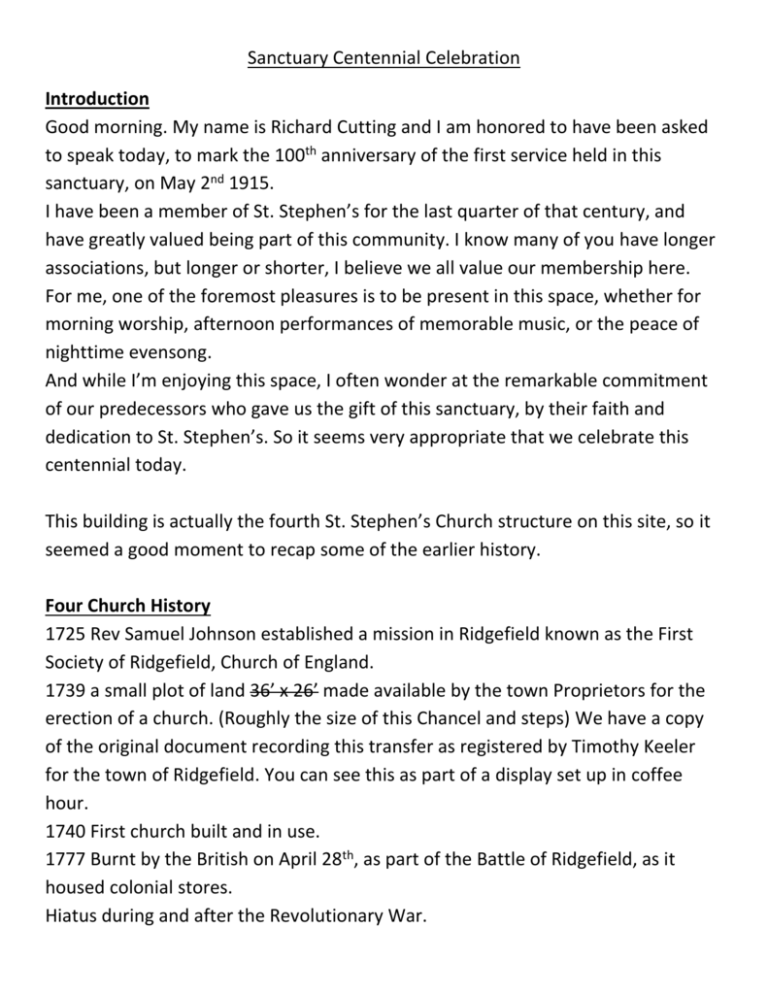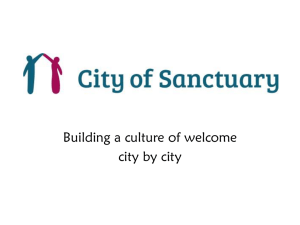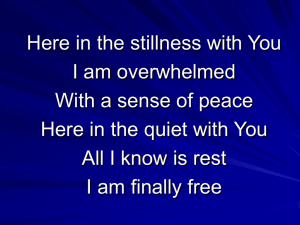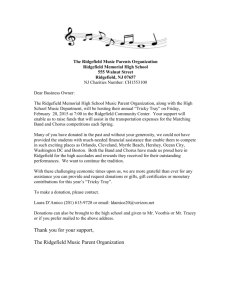Sanctuary_Centennial_Homily_2015
advertisement

Sanctuary Centennial Celebration Introduction Good morning. My name is Richard Cutting and I am honored to have been asked to speak today, to mark the 100th anniversary of the first service held in this sanctuary, on May 2nd 1915. I have been a member of St. Stephen’s for the last quarter of that century, and have greatly valued being part of this community. I know many of you have longer associations, but longer or shorter, I believe we all value our membership here. For me, one of the foremost pleasures is to be present in this space, whether for morning worship, afternoon performances of memorable music, or the peace of nighttime evensong. And while I’m enjoying this space, I often wonder at the remarkable commitment of our predecessors who gave us the gift of this sanctuary, by their faith and dedication to St. Stephen’s. So it seems very appropriate that we celebrate this centennial today. This building is actually the fourth St. Stephen’s Church structure on this site, so it seemed a good moment to recap some of the earlier history. Four Church History 1725 Rev Samuel Johnson established a mission in Ridgefield known as the First Society of Ridgefield, Church of England. 1739 a small plot of land 36’ x 26’ made available by the town Proprietors for the erection of a church. (Roughly the size of this Chancel and steps) We have a copy of the original document recording this transfer as registered by Timothy Keeler for the town of Ridgefield. You can see this as part of a display set up in coffee hour. 1740 First church built and in use. 1777 Burnt by the British on April 28th, as part of the Battle of Ridgefield, as it housed colonial stores. Hiatus during and after the Revolutionary War. After Independence achieved Second Church built and services resumed in 1791. We have original document granting land by Benjamin Smith to make this possible. Plot increased to 73’ x 43’ Roughly the size of this sanctuary space. We have some wonderful original documents pledging support by parishioners to make this possible. Money donations in pounds, shillings and pence, and promises of labor. The two leading donors were Benjamin Smith and Nathan Dauchy The plaque on the South wall records the service of Nathan Dauchy during this time as a ‘Zealous friend and supporter’ of the church. This service included a pledge, not only for money, but also for ‘Carting 1 load, 1 day , with Thomas Stebbins’ The plaque on the North wall here records the devoted service of Samuel Stebbins who became Senior Warden in 1793 at the age of 27 and was Senior Warden at the time of his death in 1836, some 43 years later!. The Stebbins connection with St. Stephens endured for several generations after that. His granddaughter, Elizabeth Stebbins Waterbury Clark was a member of St. Stephens and died in 1913 at the age of 86. This building was opened just two years later and her three sons donated $1000 for a pew in memory of their mother – see plaque in second pew. There is also a memorial inscription to her on the column supporting this pulpit. She had a grandson, Henry Austin Clark Jr. who was a wealthy collector of cars and accumulated a vast archive of personal documents, which were donated to the Benson Ford Research Center in Dearborn MI. A diligent professional archivist researcher contacted his family and learned that Henry Austin Clark’s granddaughter had a collection of historic St. Stephen’s papers, which were delivered to St. Stephen’s in August 2014. Some of these can be viewed today. Second church in use from 1791 to 1841, 50 years, so the efforts of the supporters were well rewarded. However, by 1841 the church had a full-time rector (for the first time) and the facilities were no longer adequate. The building measured just 44’ x 32’ , or about half the size of this sanctuary space. ‘Its appointments were primitive and somewhat uncomfortable’. No heat or light for example. Albert Nevins in ‘An Historical Sketch of Ridgefield’ noted: “Women and children were allowed to bring foot-stoves to church to mitigate the cold during the hour-long sermon, for the wind whistled through a series of cracks, but had any man used them, he would have been indelibly disgraced” 1841 Third Church built which addressed some of the shortcomings of the second church. Gift of adjoining land by Isaac Jones more than tripled the space available, and a Committee was instructed to erect a more suitable building nearly twice the size of the second church. Cornerstone laid in August 1841, and now preserved in the rear wall of this sanctuary. The third church also displayed the Stebbins and Dauchy memorial tablets I already mentioned Third church in use from 1841 to 1914, 73 years. But from about 1905 onwards the 70 year-old church was ‘beginning to show the afflictions of its age.’ Electric lighting had just been installed for the first time, but there is, once again, no record of any heating. The Rector at the time was Rev. John Chapman, and he was authorized by the Vestry in March 1913 to consult an architect to evaluate whether to renovate the old church or to build anew. In July the Vestry determined to proceed with detailed plans to build a new church and appointed a Building Committee to supervise the project. The Parish annual meeting in April 1914 approved the Vestry decision to proceed, and the last service in the old church held on May 25th 1914. The building committee decision was to build the new church on the site of the old one, meaning that construction would be preceded by demolition of the third church. We have an ancient photograph of the partially demolished third church, taken at the end of May 1914, shortly after the last service. The selected architect was Mr. Rainsford who designed the building and also the interior furnishings, pews, pulpit, altar and chancel furnishings. The committee originally had in mind to build a Gothic style church, but found ‘that the old colonial traditions of civil and religious life proved to be strongly grounded in the hearts of the people’. The committee were so pleased with Mr. Rainsford’s colonial style plans that they were accepted without a single dissenting vote. The cornerstone for the new church was laid on June 28th 1914. Of course this activity was accompanied by considerable discussion of how to raise the necessary funds – the church had gradually accumulated a building fund which held about half the estimated construction cost. Dr. Chapman seems to have been very successful at obtaining donations from parishioners and by September 1914 had increased the fund to about three quarters of the expected cost. To provide the remaining funds the Vestry approved the placing of a $10,000 mortgage with the South Norwalk Trust Co. Dr. Chapman’s vigorous participation in the whole undertaking was central, so it came as a real shock to the parish when he announced in July 1914, that he intended to end his 8 year tenure as rector, in order that a new rector could begin a new chapter in the life of the church in its new building. So the parish embarked on a new rector search while pressing ahead with the completion of the new church building. Both major tasks were successfully completed by May 2nd 1915, when the first service was held in this sanctuary, less than one year after the last service in the third church. Extraordinary! The May 2nd service for the Blessing of a Church was the led for the first time by the new rector, Rev William Lusk, and both he and Rev. Chapman preached on that day. As it turned out, Rev Lusk was obliged to immediately follow his predecessor’s example in seeking donations for the building costs. The sanctuary was scheduled to be consecrated by the Bishop in May 1916, but this could not happen until the mortgage had been paid off. It seems that the haste of the project resulted in some disorderly bookkeeping and an outstanding debt of $13,000 took everyone by surprise. With less than a month before the planned consecration Rev Lusk led a whirlwind campaign to clear the debts, which amounted to about a quarter of the total cost. A combination of generous donations and personal guarantees by the building committee accomplished this in, and the consecration by the Bishop went ahead as scheduled, on May 30th 1916. We have a unique photo collection (HERE) showing the finished church substantially as we know it today, although there have been a number of significant additions since 1915. The stained glass windows were added almost immediately by Mrs. F.E. Lewis as a memorial to her parents Clara and Samuel Russell. In 1927 it was determined that the church interior needed painting, and a committee of five was formed to recommend the color scheme details. There were no men on this committee. The blue ceiling we know so well, and the gold detailing on the tablets in the chancel were introduced at this time. The church now had a heating system, originally powered by a coal furnace, replaced by oil in 1937. The introduction of oil-fired heating may not have seemed such a good idea when it inflicted severe trauma to this sanctuary. Just after Christmas in 1979, the hot air furnace suffered a major failure, with the result that the entire church was filled with soot, and it was not possible to see from one end of the church to another until all the windows were opened. There followed an intense clean-up period lasting a month, when every surface had to be cleaned and painted, every organ pipe removed and vacuumed out, and every cushion sent away to be cleaned. 25 years later, in 2004 we embarked on a more deliberately planned summer-time ‘Restore & Renew’ campaign to refresh the entire sanctuary. We took out all the pews and refinished the wooden floors beneath, and we removed all the organ pipes and renewed leaky 40-year-old leather seals on the air chests. 150 families contributed to make this thorough restoration possible, and their names are recorded on the plaque in the Narthex. In 1957, at the suggestion of Rev Aaron Manderbach, the baptistry as we now know it, was created as a memorial to Rev Lusk who died in 1953. Rev Lusk had served as rector from the very first service in this sanctuary until his retirement at age 81, an extraordinary 35 years later. Other major changes in this Sanctuary were the installation of the current organ in 1962, by the Moeller Organ company, and specified by our own Dr. Alec Wyton. The crypt was created in 1979, towards the end of Rev. Manderbach’s 30 year rectorship. His recognition of the need for a suitable resting place for the cremated remains of parishioners was surely reinforced by the presence on a shelf in his study of several sets of ashes lacking a better resting place. I have mentioned the names of some of the leading figures in our history, now departed, but I would also like to highlight two more names, still living. Rev Aaron Manderbach was Rector here from 1950 to 1980 and is surely the only current parishioner who was born before this sanctuary was built. Joyce Nelson was our first Women Senior Warden, serving for 6 years from 1985 to 1991 and remembered as the first name recorded on the Senior Wardens staff. The rich history of St. Stephen’s is full of figures who deserve our remembrance, and it is inevitable that we can only acknowledge a few of them in our time this morning, so please forgive what may seem like omissions. Fourth Church Sanctuary So here we are sitting in pews that have been used by parishioners for 100 years, enjoying the beauty of this space that our predecessors created. I wonder what they would make of us and the uses we have found for our sanctuary? I like the wording of the first church records which permit the erection of ‘a Church or Meeting House’, and it seems to me that the rich variety of activity in this space today is fulfilling that vision. Of course we have regular services where we come together to Worship, and we have wonderful celebrations to mark Baptisms of new members, Marriages of couples committing lives together, and Remembrances of lives lived richly by those we loved. We are also blessed to enjoy music in many forms in a space with outstanding acoustics, enjoying choral and organ works, and even occasional Ridgefield CHIRP concerts fleeing from inhospitable weather. During the summer Vacation Bible School week, you might be amazed to see scores of young children running around this space in brightly colored T-Shirts, balloons everywhere, and fun music and dance being noisily enjoyed by children and staff alike. That sight would surely amaze the good parishioners of 1915! As St. Stephen’s extends its reach in to the community, I’m certain we will continue to see this space used in new and unexpected ways. Consider some of the changes we have seen during the first 100 years. Our seats are now, famously, FREE Hard to imagine that in 1915 this was not the case. Rent of pews was not done away with until 1919 , following some challenging disputes about who might sit where. Another change absorbed by worshippers here was the transition of the ‘Book of Common Prayer’ in use – first to the ‘1928 Book’ which was well accepted, and then to the 1979 version, which was not. Nowadays of course we look back at 1928 as ‘antiquated’, and we are beginning to see alternate prayers and liturgies being developed. Of course 21st century technology is gradually infiltrating. Nowadays you can go home after a Sunday service, and enjoy an ‘Encore presentation’ of the sermon via the internet. None of which would have been remotely comprehensible to the good people who built this space. I’m sure we will soon see use being made of visual displays to greet, or deliver messages, or illustrate sermons, because our younger generations are so accustomed to communication that is visual as well as aural. As the costs to do this decline, this seems very likely to happen. Does this idea of ‘moving with the times’ make you shudder?! If so this may be a good moment to reflect on our part in the continuing history of St. Stephen’s, and the balance between the merits of tradition and the benefits of change. Tradition vs. Change - Reflections I love this space and would be quite comfortable if it remained unchanged – so you could reasonably label me a Traditionalist. I love the presence of memorials around the church to remind us of the service of predecessors whose works we now benefit from. I love the comfortable familiarity of this space and the solidity which reassures me that changes will only occur slowly. It all seems to me to embody the wisdom of history which should not be quickly set aside. But I also know, from my own experiences that, like it or not, changes are necessary and healthy. So we all have to be open to the evolution of new sanctuary experiences that support the ongoing mission of St. Stephens. I recently read a nice expression of this tension between tradition and change, summed up as “We should respect traditions, but not be ruled by them”. Well I wonder what the next 100 years does hold in store for this space? We just put on a new roof good for that period, so we have done a bit already to secure the second centennial. This year we are ensuring that our iconic steeple endures as a landmark of Ridgefield Main Street. Ten years from now we will be celebrating the 300th Anniversary of the original formation of this church, and perhaps 100 years from now, parishioners of St. Stephens will be gathering to celebrate 200 years of worship in this building. If that seems like a challenge, remember that in Europe 200 year old church buildings are commonplace! Many of you will be involved in caring for this sanctuary and continuing to balance tradition and change. At some point I will not be around to be part of those actions, but I will be keeping an eye on things from my space already reserved in the crypt, somewhere underneath the pews over there. POINT I hope you all will continue to love and enjoy this space as much as I do – Thank You.







